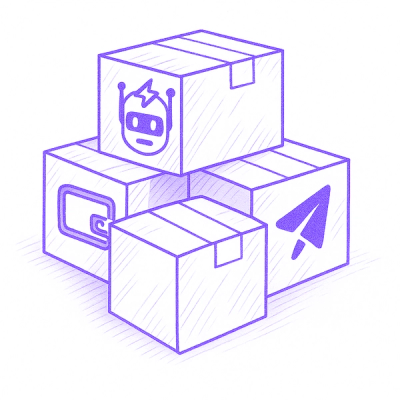
Research
Malicious npm Packages Impersonate Flashbots SDKs, Targeting Ethereum Wallet Credentials
Four npm packages disguised as cryptographic tools steal developer credentials and send them to attacker-controlled Telegram infrastructure.
@beardedtim/cms-server
Advanced tools
This is very much a WIP. It currently is aiming to do two things:
I am hoping eventually to have this as a working Blogging/page-building platform. As of now, it is easy to add basic endpoints such as /resource and /resource/:id with little configuration.
Currently, the server only supports Node v7.9.0. Checkout nvm for managing node versions
{
collections: [
{
resource: 'collectionName',
pre: [ ... ], // async functions to run BEFORE route
post: [ ... ], // async functions to run AFTER route
protected: true, // if this is a protected route
authFn: validateFunc // custom async validation
route: KoaRoute // a KoaRouter compatable obj | defaults to Base(config) | no route pre/post added
}
],
pre: [ ... ], // async functions to run BEFORE ALL routes
post: [ ... ], // async functions to run AFTER ALL routes,
}
$ git clone https://github.com/beardedtim/cms-server.git
$ cd cms-server
$ cp .env.example .env
$ yarn
$ yarn dev
You will need a mongodb instance running and have the correct MONGO_URI set in your .env file.
Below you will find 4 examples of how to use the API. To run examples:
$ git clone https://github.com/beardedtim/cms-server.git
$ cd cms-server
$ yarn
$ cd examples
$ cd defaults
$ cp .env.example .env
$ node server.js
Each request to a valid endpoint will flow:
config.pre functions are applied in ordercollections are added as routes in orderconfig.post functions are applied in orderInside of our root directory:
$ yarn add @beardedtim/cms
$ touch index.js
$ touch .env
Add the following to .env:
PORT=5001
MONGO_URI=mongodb://localhost:32770/explore
AUTH_NAME=timi
AUTH_PASS=1234
Fill in the correct MONGO_URI that you are using. If you are not already, checkout Docker and Kitematic for an almost point and click setup experience.
Then inside of index.js:
const dotenv = require('dotenv');
const Koa = require('koa');
dotenv.config();
const app = new Koa();
const cmsServer = require('./').server;
cmsServer.booststrap(app);
app.listen(5000);
We now have a functional applicaton at http://localhost:5001 with an endpoint at /documents and /documents/:id. It also has protected routes for PUT,PATCH,DELTE methods.
Go ahead and try a GET requests to http://localhost:5001/documents. It should return the following:
{
data: []
}
Which means we have no documents. Let's fix that. Add the following to your request header and make a POST request:
Authorization: Basic dGltaToxMjM0
Content-Type: application/json
Body: {
name: 'Tim'
}
This can be done inside of postman by clicking Authorization, choosing Basic and typing timi for the name and 1234 for the password. It can also be added via fetch:
fetch('http://localhost:5001/documents', {
method: 'POST',
headers: {
'Authorization': 'Basic dGltaToxMjM0',
'Content-Type': 'application/json',
},
body: JSON.stringify({
name: 'Tim'
})
})
NOTE: If you get
TypeError: Cannot create property '_id' on string, it is probably because you did not setContent-Typetoapplication/json
You should get back the following:
{
"data": {
"insertedIds": [
"58fd730a37b1e45c818003b2"
]
}
}
If you get:
{
"error": {
"code": 406,
"message": "Unacceptable content-type! It must be applcation/json"
}
}
This is because you did not set the Content-Type header correctly.
Now let's go back to GET /documents and see what we get:
{
data: [
// ... whatever you pushed
]
}
And we should have an _id. Go ahead and copy that and go to:
http://localhost:5001/documents/<ID HERE>
It should return:
{
"data": {
"_id": "58fd26666464e505d044556d",
"name": "Tim"
}
}
Or whatever you set that record to.
This is a boring record so let's delete it:
DELETE /documents/:id
DELETE /documents/58fd26666464e505d044556d
should return something like:
{
"data": {
"n": 1,
"ok": 1
}
}
And if we want to delete the whole collection of documents and start again?
DELETE /documents
should return:
{
"data": true
}
And when we GET /documents, we should be met with:
{
data: []
}
Adding Custom 404
boostrapConfig = {
// ...
post: [
async (ctx, next) => {
if (!ctx.body) {
ctx.body = {
error: {
droids: 'not the ones you are looking for',
}
}
}
}
],
}
request: GET /not/real/route
response:
{
error: {
droids: 'not the ones you are looking for'
}
}
Adding Custom Query Validation
boostrapConfig = {
// ...
pre: [
async (ctx, next) => {
const { query } = ctx.request;
const isValid = customValidation(query);
if (!isValid) {
ctx.errors.custom({
code: 406,
message: 'Not valid query!',
});
}
}
]
}
request: GET /documents?invalid=true
response:
{
error: {
code: 406,
message: 'Not valid query!',
}
}
FAQs
An abstraction for creating RESTful MongoDB microservices
The npm package @beardedtim/cms-server receives a total of 3 weekly downloads. As such, @beardedtim/cms-server popularity was classified as not popular.
We found that @beardedtim/cms-server demonstrated a not healthy version release cadence and project activity because the last version was released a year ago. It has 1 open source maintainer collaborating on the project.
Did you know?

Socket for GitHub automatically highlights issues in each pull request and monitors the health of all your open source dependencies. Discover the contents of your packages and block harmful activity before you install or update your dependencies.

Research
Four npm packages disguised as cryptographic tools steal developer credentials and send them to attacker-controlled Telegram infrastructure.

Security News
Ruby maintainers from Bundler and rbenv teams are building rv to bring Python uv's speed and unified tooling approach to Ruby development.

Security News
Following last week’s supply chain attack, Nx published findings on the GitHub Actions exploit and moved npm publishing to Trusted Publishers.